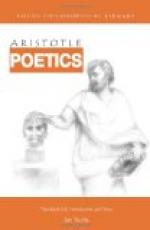Imitation, then, is one instinct of our nature. Next, there is the instinct for ‘harmony’ and rhythm, metres being manifestly sections of rhythm. Persons, therefore, starting with this natural gift developed by degrees their special aptitudes, till their rude improvisations gave birth to Poetry.
Poetry now diverged in two directions, according to the individual character of the writers. The graver spirits imitated noble actions, and the actions of good men. The more trivial sort imitated the actions of meaner persons, at first composing satires, as the former did hymns to the gods and the praises of famous men. A poem of the satirical kind cannot indeed be put down to any author earlier than Homer; though many such writers probably there were. But from Homer onward, instances can be cited,—his own Margites, for example, and other similar compositions. The appropriate metre was also here introduced; hence the measure is still called the iambic or lampooning measure, being that in which people lampooned one another. Thus the older poets were distinguished as writers of heroic or of lampooning verse.
As, in the serious style, Homer is pre-eminent among poets, for he alone combined dramatic form with excellence of imitation, so he too first laid down the main lines of Comedy, by dramatising the ludicrous instead of writing personal satire. His Margites bears the same relation to Comedy that the Iliad and Odyssey do to Tragedy. But when Tragedy and Comedy came to light, the two classes of poets still followed their natural bent: the lampooners became writers of Comedy, and the Epic poets were succeeded by Tragedians, since the drama was a larger and higher form of art.
Whether Tragedy has as yet perfected its proper types or not; and whether it is to be judged in itself, or in relation also to the audience,—this raises another question. Be that as it may, Tragedy—as also Comedy —– was at first mere improvisation. The one originated with the authors of the Dithyramb, the other with those of the phallic songs, which are still in use in many of our cities. Tragedy advanced by slow degrees; each new element that showed itself was in turn developed. Having passed through many changes, it found its natural form, and there it stopped.
Aeschylus first introduced a second actor; he diminished the importance of the Chorus, and assigned the leading part to the dialogue. Sophocles raised the number of actors to three, and added scene-painting. Moreover, it was not till late that the short plot was discarded for one of greater compass, and the grotesque diction of the earlier satyric form for the stately manner of Tragedy. The iambic measure then replaced the trochaic tetrameter, which was originally employed when the poetry was of the Satyric order, and had greater affinities with dancing. Once dialogue had come in, Nature herself discovered the appropriate measure. For the iambic is, of all




